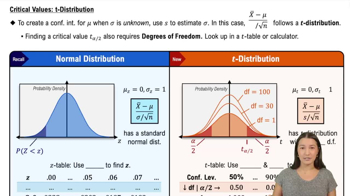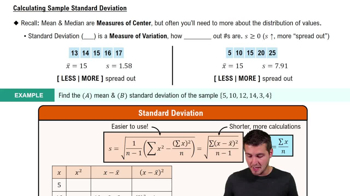Ages of Prisoners The accompanying frequency distribution summarizes sample data consisting of ages of randomly selected inmates in federal prisons (based on data from the Federal Bureau of Prisons). Use the data to construct a 95% confidence interval estimate of the mean age of all inmates in federal prisons.
Table of contents
- 1. Intro to Stats and Collecting Data1h 14m
- 2. Describing Data with Tables and Graphs1h 55m
- 3. Describing Data Numerically2h 5m
- 4. Probability2h 16m
- 5. Binomial Distribution & Discrete Random Variables3h 6m
- 6. Normal Distribution and Continuous Random Variables2h 11m
- 7. Sampling Distributions & Confidence Intervals: Mean3h 23m
- Sampling Distribution of the Sample Mean and Central Limit Theorem19m
- Distribution of Sample Mean - Excel23m
- Introduction to Confidence Intervals15m
- Confidence Intervals for Population Mean1h 18m
- Determining the Minimum Sample Size Required12m
- Finding Probabilities and T Critical Values - Excel28m
- Confidence Intervals for Population Means - Excel25m
- 8. Sampling Distributions & Confidence Intervals: Proportion1h 12m
- 9. Hypothesis Testing for One Sample3h 29m
- 10. Hypothesis Testing for Two Samples4h 50m
- Two Proportions1h 13m
- Two Proportions Hypothesis Test - Excel28m
- Two Means - Unknown, Unequal Variance1h 3m
- Two Means - Unknown Variances Hypothesis Test - Excel12m
- Two Means - Unknown, Equal Variance15m
- Two Means - Unknown, Equal Variances Hypothesis Test - Excel9m
- Two Means - Known Variance12m
- Two Means - Sigma Known Hypothesis Test - Excel21m
- Two Means - Matched Pairs (Dependent Samples)42m
- Matched Pairs Hypothesis Test - Excel12m
- 11. Correlation1h 6m
- 12. Regression1h 50m
- 13. Chi-Square Tests & Goodness of Fit1h 57m
- 14. ANOVA1h 57m
7. Sampling Distributions & Confidence Intervals: Mean
Confidence Intervals for Population Mean
Problem 7.3.8
Textbook Question
use the given information to find the number of degrees of freedom, the critical values X2L and X2R, and the confidence interval estimate of σ. It is reasonable to assume that a simple random sample has been selected from a population with a normal distribution:
Heights of Men 99% confidence; n=153, s=7.10 cm.
 Verified step by step guidance
Verified step by step guidance1
Step 1: Identify the degrees of freedom (df). The degrees of freedom for a chi-square distribution is calculated as df = n - 1, where n is the sample size. In this case, n = 153, so df = 153 - 1.
Step 2: Determine the critical values X²L and X²R. For a 99% confidence level, the significance level (α) is 1 - 0.99 = 0.01. Divide α into two tails: α/2 = 0.005 for each tail. Use a chi-square distribution table or statistical software to find the critical values for df = 152 at α/2 = 0.005 (right tail) and 1 - α/2 = 0.995 (left tail).
Step 3: Use the formula for the confidence interval of the population standard deviation (σ). The formula is: CI for σ = [sqrt((df * s²) / X²R), sqrt((df * s²) / X²L)], where s is the sample standard deviation, df is the degrees of freedom, and X²L and X²R are the critical values from Step 2.
Step 4: Substitute the known values into the formula. Use df = 152, s = 7.10 cm, and the critical values X²L and X²R obtained in Step 2. Compute the lower and upper bounds of the confidence interval for σ.
Step 5: Interpret the result. The confidence interval provides a range of plausible values for the population standard deviation (σ) at the 99% confidence level. Ensure the units (cm) are included in the final interval.
 Verified video answer for a similar problem:
Verified video answer for a similar problem:This video solution was recommended by our tutors as helpful for the problem above
Video duration:
7mPlay a video:
Was this helpful?
Key Concepts
Here are the essential concepts you must grasp in order to answer the question correctly.
Degrees of Freedom
Degrees of freedom (df) refer to the number of independent values or quantities that can vary in an analysis without violating any constraints. In the context of a sample, df is typically calculated as the sample size minus one (n-1). This concept is crucial for determining the appropriate statistical tests and critical values, especially in t-distributions and chi-squared tests.
Recommended video:

Critical Values: t-Distribution
Critical Values
Critical values are the threshold points that define the boundaries of a confidence interval or the rejection region in hypothesis testing. For a chi-squared distribution, critical values (X2L and X2R) are determined based on the degrees of freedom and the desired confidence level. These values help in assessing whether the sample statistic falls within a specified range, thereby influencing conclusions about the population parameter.
Recommended video:

Critical Values: t-Distribution
Confidence Interval for Standard Deviation
A confidence interval for the standard deviation (σ) provides a range of values within which the true population standard deviation is likely to fall, given a certain level of confidence (e.g., 99%). This interval is calculated using the sample standard deviation and the chi-squared distribution, which accounts for the sample size and variability. Understanding this concept is essential for making inferences about population parameters based on sample data.
Recommended video:
Guided course

Calculating Standard Deviation

 4:48m
4:48mWatch next
Master Population Standard Deviation Known with a bite sized video explanation from Patrick
Start learningRelated Videos
Related Practice
Textbook Question
